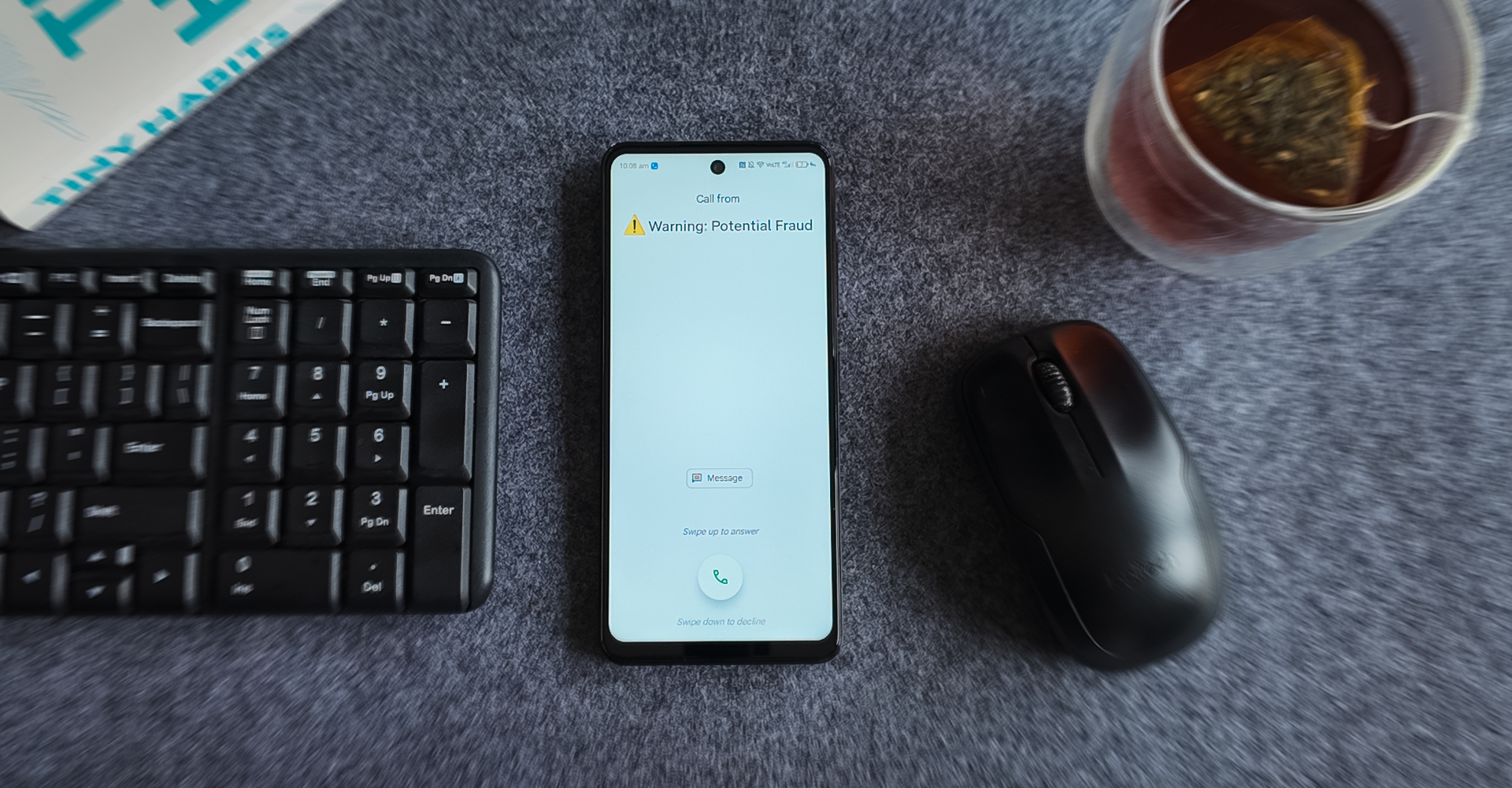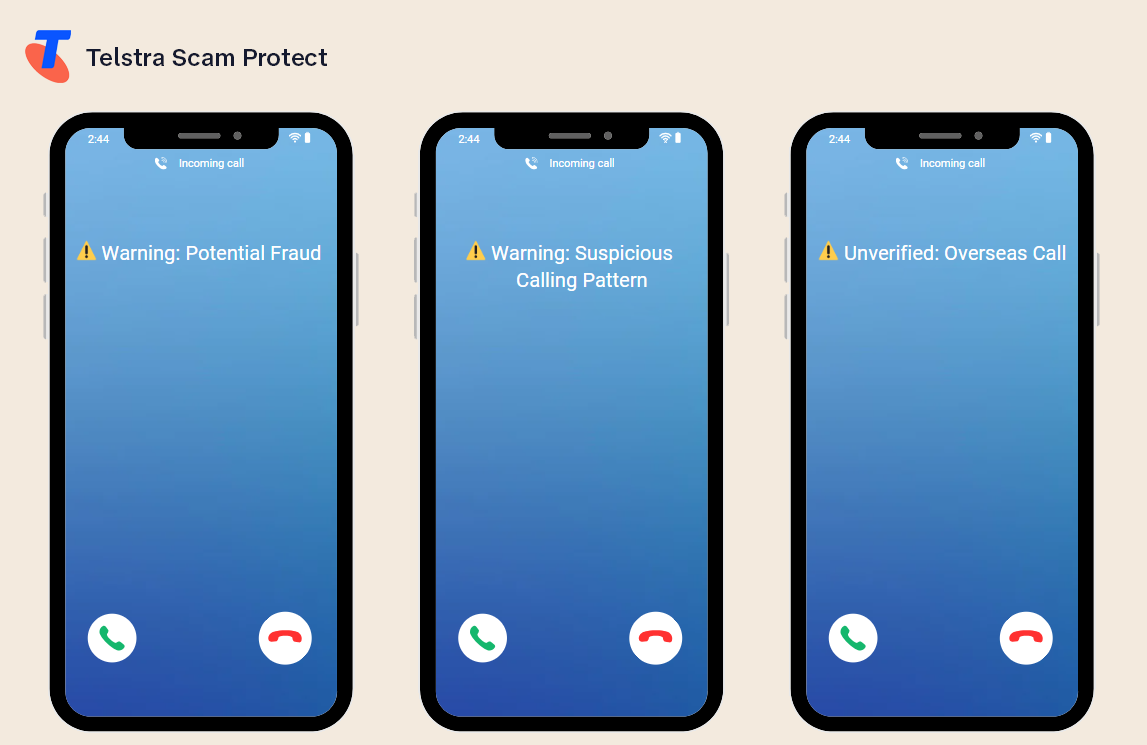How we’re raising the alarm on potentially suspicious phone calls
42% of Australians who own a mobile device admit to being less likely to answer calls out of concern about being scammed. We want to change that.

How often have you seen an unknown number flash up on your mobile screen and thought – is this a scammer or a legitimate call? The fact is it could be a scammer operating from overseas or a legitimate business simply cold calling you - knowing the difference can be distressing and confusing. And that means we’re often less likely to pick up.
That’s why we’ve recently launched Telstra Scam Protect: a new feature that warns you when an incoming call might be suss, prompting you to reconsider answering.
What is Telstra Scam Protect?
Telstra Scam Protect has been developed to give customers more control by helping them make more informed decisions on which calls to answer, and which are better off ringing through to voicemail.
The new, in-house solution alerts our customers to suspicious or unverified calls by displaying a message in real time, directly from their device screen:

⚠️ Warning: Potential Fraud: This message applies to calls that may be fraudulent, either calling you from a spoofed number (when a scammer falsifies the number to make it look legitimate, so you're tricked into answering it) or has a suspicious calling pattern.
⚠️ Unverified: Overseas Call: The call appears to be from a local mobile number, but our network detects it’s coming from overseas and may be suspicious. This message only appears for calls deemed suspicious.
⚠️ Warning: Suspicious Calling Pattern: Indicates a high volume of incoming traffic from a single number. This is associated with potential spam and means you should be cautious.
Scammers: a persistent threat
Phone calls are still a popular way for scammers to catch people out. According to the ACCC’s recent Targeting Scam Report, phone scams accounted for the highest overall financial losses among all contact methods in 2024, with $107.2 million reported lost across 2,179 reports.
While we block more than 11m scam calls on average every month, there’s always more to do - cyber criminals constantly adapt their techniques to slip through the net.
Using a variety of tactics to evade detection and appear legitimate, they often have one goal in mind: persuading unsuspecting users into handing over information or money.
The reality is, while we’re blocking millions of scam calls, we need to be careful not to unintentionally block genuine communications, which is part of the reason why some malicious calls can unfortunately still slip through.
How scam fears are changing Aussie call habits*
Women on high alert: Nearly half of Aussie women (47%) said they would be less likely to answer unknown calls on their mobiles or smartphones due to scam concerns, compared to 36% of men.
Generational caution: Generationally, Gen X has the highest proportion of Aussies who are cautious in answering unknown calls, with a 45% hesitancy rate. They’re closely followed by Baby Boomers (42%) and Millennials (41%), while Gen Z is slightly less wary at 39%.
State-wide vigilance: Queenslanders show the highest caution, with 47% hesitant to answer unknown calls. They are closely followed by Victorians and South Australians, both at 42%. In contrast, Western Australia (38%) and New South Wales (37%) have the smallest proportion of residents who are hesitant when picking up unknown calls.
What is call Spoofing?
Call Spoofing is where a call is deliberately made to appear as though it is originating from another number (like in the case of outbound calls from a business call centre).
When used with malicious intent, Call Spoofing is where a phone scammer can falsify the calling number to trick a user into picking up or making a call look more legitimate.
Scammers know that people are more likely to pick up the phone to a number that appears ordinary, rather than one that appears as private, blocked, or from overseas.
Spoofing used for scam purposes often occurs when a scammer originates calls, usually via “robocalling” technology, with fake caller IDs i.e. the scammers are using technology to originate calls with legitimate Australian numbers included as the caller ID.
While Telstra has strict controls to help prevent caller ID spoofing within our network, spoofing can still occur with calls originating from outside of our network that reach our customers. That means we don’t always have enough information to confirm if a call is being made by a scammer to block it.
How do I access Telstra Scam Protect?
The capability is integrated directly into Telstra’s network and is now available to all our retail and wholesale services (with compatible devices) including Boost Mobile, Belong and others.
And the best part? You don’t need to do anything to activate it –alerts appear automatically at no extra cost.
Since starting roll out at the end of December 2024, Telstra Scam Protect warning messages have been applied to over 10 million calls– alerting Australians to exercise caution on potentially harmful calls.
Telstra Scam Protect is just one of a series of recent initiatives that we’ve launched to help better protect customers from scams. These include:
- Device Security Essentials: a free feature embedded into the MyTelstra App to help protect your device from online threats, powered by McAfee.
- Scam Indicator and Fraud Indicator, developed by Quantium Telstra in partnership with Telstra and CBA – initiatives that are helping protect joint customers from fraudulent calls and identity theft.
While these initiatives help keep you better protected, combatting scammers is a team sport and we all have a role to play to stay alert.
Top tips to avoid scam calls: Nothing beats good common sense
Screen unknown numbers: If you get a call from a number you don't know, it's best to let it go to voicemail. And if you're not sure if a caller is who they say they are, it's ok to hang up. Also, if you miss a call and feel unsure, the Telstra Scam Protect alert will appear in your missed call log.
Check if the call is real: Never use the contact details given by a caller, written in an email or an SMS. Scammers can easily impersonate someone calling from a major company or organisation. Always fact-check by looking up the official contact information on the organisation's website or another trusted source.
Don't rush to act: Scammers like to create a sense of urgency. That's why it's so important to stop and check. Ask yourself if you really know who you're communicating with and never give out any personal information, financial details or remote access to your computer. Immediately hang up on anyone who tries to threaten or intimidate you.
Stay informed about the latest phone scams identified by our cyber team here.
For customers with vision impairments, if your mobile device already vocalises contact names when you receive calls, Telstra Scam Protect will work in the same way. Any warnings will be read out to you just like a contact’s name.
Footnote on National Research:
Our national research was conducted in partnership with YouGov. The study was completed online between 3 – 6 September 2024, with a nationally representative sample of 1,037 Australians aged 18 years and older. The data was weighted by age, gender, and region to reflect the latest ABS population estimates, February 2024 – January 2025.


